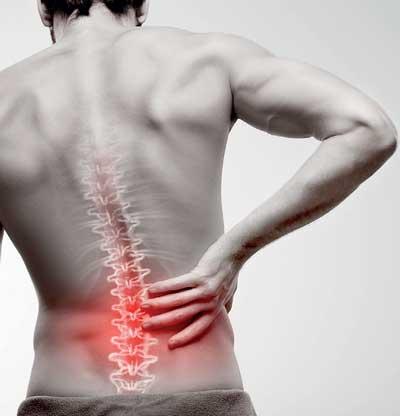Reply To:
Name - Reply Comment
 Happiness can be destroyed even by an existence of a minute physical pain. Joint pains and related muscular skeletal disorders are recorded comparatively in a high frequency in present society. Incidents of lower back pain brought as complaints by the individuals are increased without the impact of age. From mild to severe onsets of lower back pains can be observed with many underlying pathogenesis. Hence, negligence of a minute pain may lead to chronic severe sufferings, because of the continuation of the underlying pathogenesis.
Happiness can be destroyed even by an existence of a minute physical pain. Joint pains and related muscular skeletal disorders are recorded comparatively in a high frequency in present society. Incidents of lower back pain brought as complaints by the individuals are increased without the impact of age. From mild to severe onsets of lower back pains can be observed with many underlying pathogenesis. Hence, negligence of a minute pain may lead to chronic severe sufferings, because of the continuation of the underlying pathogenesis.
Though, prevention is more effective than expensive resources for medication in various spectra of diseases, the majority of society is keen on being aware of their own health only after the onset of an ailment.

It is the same as in the case of lower back pains too. Lower back pain and its radiation along the lower limbs mostly prevail and can be developed behind various etiopathogenesis. This radicular low back pain has been diagnosed as sciatica or Gidhrasi in term of Ayurveda.
Although, Ayurveda medical science elicits conceptually and therapeutically applicable line of treatment for lower back pains and Gidhrasi (sciatica), prevention of its onset and progression of pathogenesis is admired with simple lifestyle modifications.
Gidhra is a bird known as vulture in English vocabulary. The disease Gidhrasi is named so due to the typical gait pattern of the patients suffer from Gidhrasi sciatica that is equal to the gait of that vulture. Other than this the pain felt by the patient is severe and similar to the pain one feels when trapped in vultures’ beak.
Causative factors related to the origin of Gidhrasi (sciatica) may be physiological or pathological.
Most often causes and risk factors associated with the etiopathogenesis of Gidhrasi (sciatica) are improper sitting postures, frequent laborious activities such as weight lifting, impact of the jerky movements to the body, bending and twisting due to wrong posture maintaining, inflammation, infections, smoking, degenerative outcomes with ageing, tumours and carcinoma, diseases related to the spinal cord etc. These causes may lead to disc prolapse and herniation along the lumbosacral vertebrae. From another perspective, nerve root compression and obstruction to the course of sciatic nerve cause to raise radicular lower back pain along the lower limbs.
Equilibrium of the three major intrinsic factors of the human body viz. Vata, Pitta and Kapha is a major responsible factor elaborated in Ayurveda medical science to maintain positive health. Imbalance of these three, especially the Vata Doha which is responsible for the motor and sensory functioning of the body create different types of disorders. Lower back pain and Gidhrasi (sciatica) is also having this impact from intrinsic factors.
Provocation of the Vata Doha impairs the proper functioning of motor and sensory systems also. Hence, the modifiable risk factors which are causes for provoking Vata Doha such a as excessive indulgence in oily, flour foods, walking long distances by feet, excessive sitting and maintenance of the wrong postures during sitting, lifting weights, sleeping and standing, awaking at nights and suppression of natural urges etc. should be avoided. Sleeping on a firm surface is also helpful to manage the disease.
It seems that most of the causative factors are modifiable with lifestyle such as maintaining correct postures while sitting, standing and sleeping, lifting and stretching heavy things, smoking cessation and healthy behavioural change to prevent the underline disease conditions in some extent.
Stiffness, pain, piercing pain, tingling sense over the buttock, waist, thigh, knee, calf and foot in
order are the major clinical features of the
Gidhrasi (sciatica).
Appropriate lifestyle modifications while practicing treatments may give relieve from the disease. The treatments have been decided in accordance with the underlying cause. Elimination of the etiopathogenesis of the course of disease leads to cure the disease.
Periodical follow-up of the recommended Ayurveda treatment protocols which are selective in accordance with the examination of the patient and disease plays a considerable impact on cure the sufferer. Although, the disease has an underlying non modifiable causative factor, the patient feels an ease when baring the condition as this treatments used to eliminate the root cause and pacify the disequilibrium. Re-establishing of the impaired digestive and metabolic functions by the appropriate treatments cause to provide necessary nutritional components to heal the weakened tissues and strengthen the effectiveness of the treatments. Both internal and external treatment protocols are used during the line of treatment. Oil applications, fomentation, Panchakarma treatments are some of external treatments applicable to cure lower back pain and Gidhrasi (sciatica) along with internal treatments.
Prior attention to the signs and symptoms would help prevent much suffering and it is not wise to neglect a mild pain. Appropriate treatments and lifestyle modifications aid in uplifting the quality
of life and making life happy.